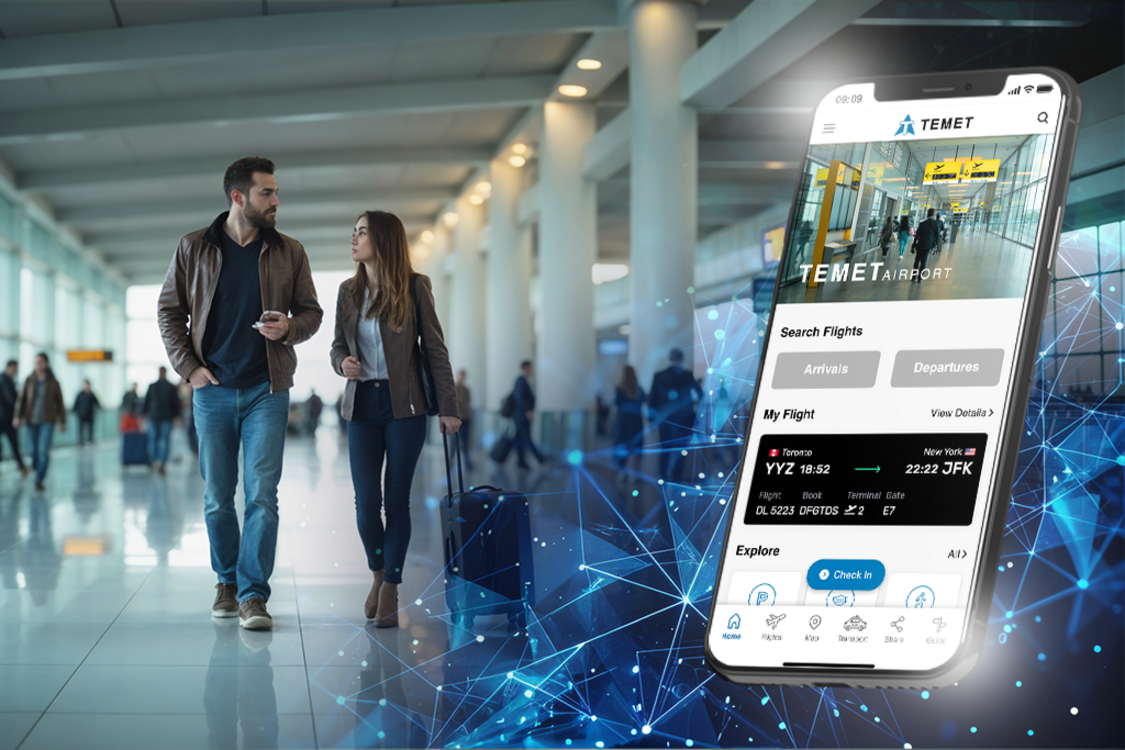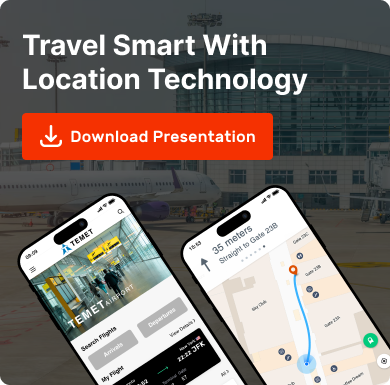Transportation Hubs

Airports are getting smarter and not just because they have shiny new terminals or faster Wi-Fi. Additionally, behind the scenes, a quieter revolution is taking place — driven by real-time location data and IoT in aviation. Right from streamlining passenger queues to optimizing aircraft turnaround times, these technologies are fundamentally changing how location data improves airport operations.
Why Real-Time Location Data Is Gaining Urgency in Aviation
- Air travel is booming again: In 2022, international air passenger volume jumped by 47% as restrictions eased — and it’s only rising.
- Traffic will double: By 2043, global air travel is projected to double, putting immense pressure on airport infrastructure.
- Innovation is key: To grow without chaos, airports are adopting real-time location intelligence, big data and smart airport solutions.
- Massive investment ahead: The global aviation IoT market was valued at $11.36 billion in 2024 and is forecast to hit $78.17 billion by 2033, growing at nearly 24% annually.
Surely, stakeholders are betting big on technology used in airports that can streamline operations, enhance the passenger experience and scale effortlessly.


Smarter Passenger Flow: From Guesswork to Precision
Ever missed a flight because of a never-ending security line? Airports are fixing that by tracking people anonymously in real-time and reacting before bottlenecks form.
- Toronto Pearson International Airport deployed AI-powered video analytics to monitor customs queues. The result? Arrival processing time dropped from 30 minutes to under 6 minutes during peak season.
- Delhi Airport’s Terminal 3 uses 500+ ceiling sensors to monitor crowd flow and wait times at check-in, security and immigration. Screens display real-time queue updates and alerts to notify staff when lanes need to open.
- Amsterdam Schiphol Airport takes it a step further with predictive modelling. Their system doesn’t just monitor—it forecasts. Staff can respond before a crowd even becomes a problem.
These tools not only reduce stress but also improve the airport passenger experience significantly. For airlines, that means fewer last-minute gate changes, faster boarding and fewer missed connections.
Baggage Tracking: Say Goodbye to Lost Luggage
One of the top complaints about air travel? Missing bags. But with IoT in aviation, that’s changing fast.
- According to SITA’s 2024 report, baggage mishandling dropped 9% globally in one year thanks to RFID tags and automation.
- Delta Air Lines now tracks luggage in real-time using RFID tags scanned across 84 airports. Passengers can check bag status via the app—reducing anxiety and support calls.
- At Hong Kong International Airport, automated baggage handling systems process over 15,000 bags per hour with incredible accuracy.
Meanwhile, airports like Incheon and Miami have rolled out smart asset tracking for everything from wheelchairs to catering trucks. If something strays from its zone, the system flags it instantly.
It’s not just about convenience. Every mishandled bag costs money and efficient tracking saves both time and customer loyalty.
Indoor Navigation & Real-Time Updates: Guiding Passengers Smarter
Today’s traveller expects more than just signage—they want their phone to guide them like Google Maps. That’s where indoor navigation, powered by real-time location data, steps in.
- Rome Fiumicino Airport implemented a turn-by-turn digital map system that reduced confusion and eased foot traffic congestion.
- Singapore Changi Airport’s app lets travellers check live wait times and even get nudged when it’s their turn for boarding or security.
- Miami International Airport is developing an AI-powered chatbot that gives personalized directions via text—like having a 24/7 concierge in your pocket.
Platforms like Mapsted take this even further. Their minimal hardware indoor navigation uses your smartphone’s sensors—no Wi-Fi, no Bluetooth beacons—to provide seamless directions and real-time updates. That’s less infrastructure, lower maintenance and better scalability for large venues.
The Big Picture: IoT + AI + Big Data = Smart Airport Ops
Behind all these improvements is a common thread: integration.
- London Heathrow’s APOC (Airport Operations Centre) combines real-time data from baggage systems, weather, traffic, security and more—allowing teams to collaborate and make informed decisions on the fly.
- Schiphol Airport’s “Deep Turnaround” AI system uses video analytics to monitor and optimize aircraft handling. Since adoption, they’ve reduced missed runway slots by 25% and gate changes by 50%.
These systems rely on big data analytics and AI to not only react but also predict. That’s the holy grail: knowing when and where an issue will arise and solving it before passengers notice.
The Future: From Reactive to Predictive
As passenger numbers continue to grow, the question isn’t just “How do we manage the crowd?” but “How do we stay ahead of it?”
Here’s where smart airport solutions will focus next:
- Digital twins of terminals to simulate operations and test changes.
- 5G private networks (like Miami’s 2024 rollout) for faster, more reliable IoT connectivity.
- AI-driven scheduling to dynamically assign gates, staff and even restrooms based on usage.
And Mapsted’s real-time heatmaps and crowd analytics? They give airports a complete view of passenger behaviour—helping managers make quick decisions that improve flow and safety without costly infrastructure changes.
Final Thoughts: The Airport of Tomorrow Is Already Here
Real-time location data has moved from a “nice-to-have” to a “can’t-operate-without” in the aviation world. And it’s working.
- Lines are shorter.
- Bags are safer.
- Passengers are better informed.
- Staff are more responsive.
- And airports are doing more with less.
The future of airport operations isn’t just high-tech, it’s high-touch. It’s about creating smoother, smarter journeys with data and design working hand in hand.
For decision-makers in the aviation space, the question now isn’t whether to invest in location intelligence—it’s how quickly you can scale it.
Because in this sky-high race for efficiency and satisfaction, the winners will be those who always know where their passengers are—and where they need to go next. If you found this blog helpful, read our article on Top Sustainability Features in Modern Airport Designs Around the World or watch our video on Revolutionizing Airport Navigation: Mapsted at Miami International Airport to see these innovations in action.
Frequently Asked Questions
Q1. What exactly does real-time location data do for airports?
Ans. Think of it as giving airports a live map of what’s happening on the ground. It helps staff see where passengers are moving, how long lines are, where baggage is and even if a piece of equipment is idle. This means fewer delays, faster reactions and a smoother airport passenger experience for travellers.
Q2. How is IoT actually used in aviation?
Ans. It’s everywhere — from sensors in baggage belts to trackers on cleaning carts and fuel trucks. Airports and airlines use it to know what’s where and what needs attention in real-time. For example, if a restroom gets unusually busy, a cleaning team is automatically sent before complaints start rolling in.
Q3. So how do airports use big data?
Ans. Big data is like the brain behind the scenes. It looks at thousands of data points — foot traffic, flight schedules, wait times — and helps airports plan smarter. Want to avoid long queues at security? Big data already knows the busiest times and helps staff up before it becomes a problem.
Q4. Can this tech really help with lost baggage?
Ans. Absolutely — and it’s already working. Airlines now use RFID tags and tracking systems that follow your bag every step of the way. If it gets delayed, you can see where it is in the app. Thanks to this, the number of mishandled bags is going down, even with rising passenger numbers.
Q5. What do people mean by “smart airport solutions”?
Ans. It’s just a fancy term for airports using tech to work better. AI, location data and predictive analytics — all combined to improve everything from check-in to gate boarding. For passengers, that means less stress, shorter lines, helpful apps and real-time info exactly when you need it.
Q6: And where does Mapsted fit into all this?
A: Mapsted brings something unique to the table — indoor navigation that doesn’t need beacons, Wi-Fi or Bluetooth. Using just your phone’s built-in sensors, it offers turn-by-turn directions inside airports with minimal hardware for IoT additions. It’s faster to install, easier to manage and a big step toward making travel smoother for everyone.
